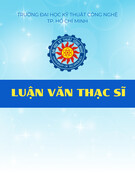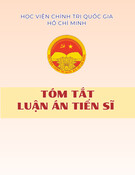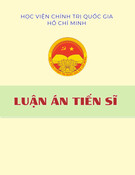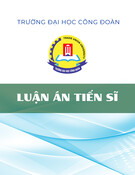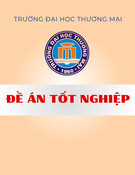
1
INTRODUCTION
1. Rationale
It is believed that the establishment of livelihood vulnerability index is necessary in
order to categorize the vulnerability for each country, region and community. These indices
serve as the basis for direct intervention in the most severely affected areas (Alam, 2017;
Bhuiyan et al, 2017; Jacobson et al., 2018).
Perch (2011) also agreed as he proved that if
adaptation policies (such as national adaptation programme of action ) are developed
without considering the livelihoods of vulnerable groups, they are unlikely to succeed.
Therefore, many evaluation methods on livelihood vulnerability have been constructed and
developed. Among them, Livelihood Vulnerability Index (LVI) proposed by Hahn et al.
(2009) has been used by many scholars (Sarker et al., 2019; Zhang and associates, 2019;
Peng et al, 2019; Tjoe, 2016; Adu et al., 2018; Huong et al, 2019). However, most of the
studies applying LVI used weighted balance, which was criticized as the same weights were
applied to different components (Beccari, 2016; Miller et al., 2013; Abeje et al., 2019).
Therefore, it is necessary to develop a more suitable calculation method for LVI to produce
more convincing results.
The development of LVI to classify the vulnerability for each country, region and
community is essential, nevertheless most previous studies only calculated the index
without considering the overall importance of vulnerable components on livelihood. It is
neccessary to provide a general picture of impacts by vulnerable elements (exposure,
sensitivity and adaptive capacity) on livelihood as well as study factors that reduce negative
effects on vulnerability on livelihood in order to devise effective adaption policies.
Therefore, more specialized studies are neccessary in order to have a clearer picture of
vulnerable components' influence on livelihood and to take into
The necessity of this topic not only originates from the knowledge gap but also from
the practical needs. It is found that climate change has adversely affected the world economy
through the increased frequency of extreme events such as droughts, floods, storms, and sea
level rise (Anik et al., 2018). Although many countries are affected by global climate change,
the biggest impact will happen to countries that rely on agricultural production (Mendelsohn,
2008). Vietnam, a rice-based agricultural economy, will be hit severely by climate change,
especially in the Mekong Delta, which provides about 50% of the country's output. This
region will be extremely vulnerable and affected by natural disasters, especially salinity
intrusion (Vu et al., 2018). In fact, the Mekong Delta has been identified as one of the regions
in the world being most vulnerable to climate change (Nguyen et al., 2019) and most studies
claimed that salinity intrusion is one of major problems in the Mekong Delta, which tends to
be exacerbated in the future due to sea level rise and declining upstream discharge (Tran Quoc
Dat et al., 2012; Tran Hong Thai et al., 2014). This can lead to the region's rice production
2
will be decreased by at least half and Vietnam would be a country without rice exports (Tran
Quoc Dat et al., 2012). Threats of food security, depletion of natural resources, shrinking
cultivated areas will negatively affect citizens' livelihood... These are great challenges faced
by the Mekong Delta when resolving salinity intrusion to improve the socio-economic
development.
In the past, there were many research on sustainable livelihoods, vulnerability
assessment in the Mekong Delta (Ministry of Science and Technology, 2016; Nguyen
Thanh Binh, 2012; Tran Hong Thai et al. et al, 2014; ADB, 2011; Dinh et al, 2012;
Birkmann et al, 2012; Miller, 2014; Trung and Thanh, 2013; Can et al, 2013; Phung et al,
2016 ...). However, these studies mainly focused on climate change (temperature change,
rainfall) and did not specify which form of livelihood is vulnerable in the context of salinity
intrusion. Furthermore, authors of these studies did not quantify the impact of salinity
intrusion on households' livelihood or research factors which could minimize the negative
effects of salinity intrusion. Quantifying these effects will provide important insights in the
amount of money should be spent on mitigation, and also orientate where, when and how
the adaptation policy should be implemented (Mendelsohn, 2008). Therefore, it is essential
for further studies to study which form of livelihood is vulnerable in the context of salinity
intrusion as well as factors that reduce influence of salinity intrusion in the Mekong Delta in
order to provide appropriate policies.
Taken into account these practical requirements and research shortcomings, the
author selected "Vulnerability and livelihood outcomes in the context of salinity intrusion in
the Mekong Delta" as the topic of the dissertation.
2. Research objectives and questions
Research objectives
General Objective: The research was conducted to evaluate livelihood vulnerability in
the context of salinity intrusion in the Mekong Delta to indicate which areas and subjects are
more vulnerable. Concurrently, the study also aimed at assessing the impacts of LVI
components (exposure, sensitivity, adaptive capacity) on livelihood outcomes, and taking
into account the regulatory role of adaptive capacity in mitigating the effects of salinity
intrusion on livelihood outcomes in the Mekong Delta.
Specific objectives
- To complete the theoretical model in evaluating impacts of LVI components
on livelihood outcomes in the context of salinity intrusion in the Mekong Delta.
- To measure livelihood vulnerability in the context of salinity intrusion in the
Mekong Delta according to each local area and households' characteristics based on
the analysis of exposure, sensitivity and adaptive capacity.
- To evaluate the influence of LVI components on livelihood outcomes in the





